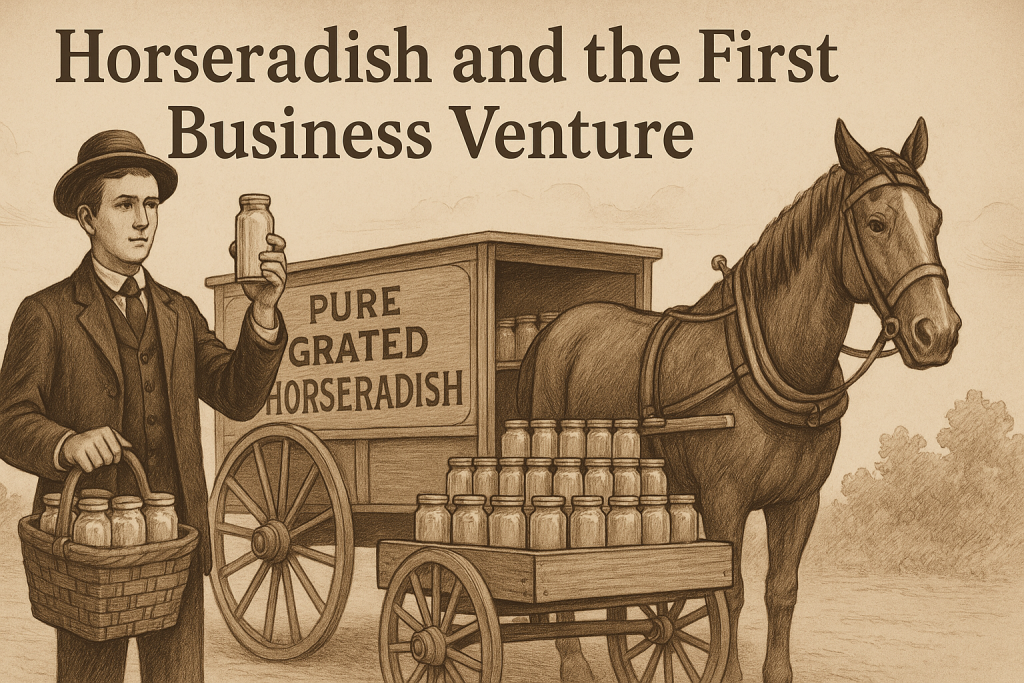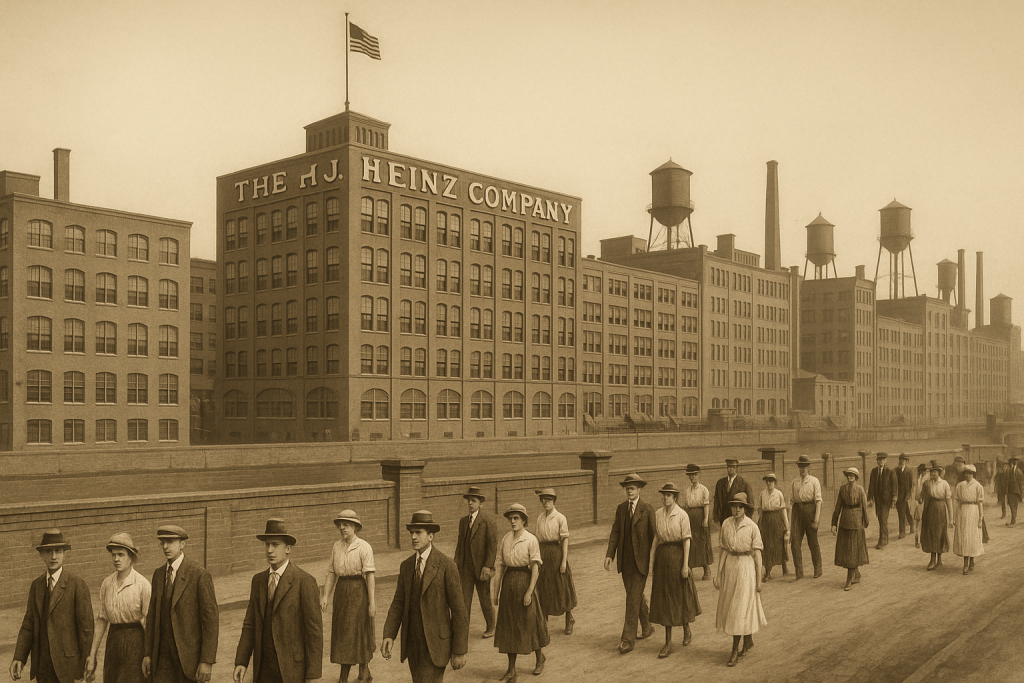Henry John Heinz (1844–1919) was an American entrepreneur and the founder of the H. J. Heinz Company in Pittsburgh . Born to German immigrants on Pittsburgh’s South Side, he grew up in Sharpsburg, Pennsylvania, where he learned the value of hard work and honesty . As a boy he earned a reputation as a prodigious salesman – by age 17 he had sold over $2,000 of produce from his mother’s four-acre garden in a single summer . Heinz studied bookkeeping at Duff’s Mercantile College while still helping at the family brickyard , but ultimately decided that a career in business – not the ministry his parents had intended – was his calling . These early experiences of faith, practical education, and honest commerce prepared Heinz to build a food empire based on quality and consumer trust.
Immigrant Roots and Early Endeavors
Henry grew up steeped in his family’s Lutheran faith . In 1849, when he was five, the Heinz family moved from Birmingham (now part of Pittsburgh) to the nearby village of Sharpsburg . There, young Henry balanced church school with farm work. He helped tend the family garden and learned the spice recipes of his German mother. By his teens he was selling tomatoes, cucumbers and other garden vegetables around town, using a wheelbarrow and later a wagon to carry produce. The results were impressive: before he even turned 17, Heinz had earned more than $2,000 in one summer selling vegetables and spices . These early successes convinced him that his talents lay in business. He took bookkeeping classes at Pittsburgh’s Duff’s Mercantile College while still helping in the brick factory , gaining the practical skills he would need. In this way, Heinz’s immigrant upbringing and industrious youth instilled in him the conviction that honest, hard work (and a little business savvy) would pave the way to success.
Horseradish and the First Business Venture

At 21, Henry Heinz launched his first business on the side. He began bottling and selling pure grated horseradish – a recipe from his mother – to local grocers . To highlight the quality of this product, Heinz used clear glass jars rather than the dark bottles competitors preferred. This bold choice let customers see that the horseradish was fresh and unadulterated . He initially carried the jars himself in a hand basket, then upgraded to a pushcart. As demand grew, he even acquired a horse-drawn wagon (nicknamed the “Heinz Hitch”) to reach more markets . In 1869, Heinz married Sarah Young and went into partnership with friend L. Clarence Noble. They opened the Anchor Pickle and Vinegar Works (later known as Heinz, Noble & Company) on Pittsburgh’s North Side . This factory produced an assortment of condiments – bottled pickles, celery sauce and vinegar, fruit jams and jellies, along with that now-famous pure grated horseradish . For example, by 1872 their product line included:
- Bottled pickles (in brine or vinegar)
- Celery sauce and vinegar
- Fruit jams and jellies
- Heinz’s signature pure grated horseradish
Each of these items was marketed on the promise of quality and purity.
Panic of 1873 and a New Company
Disaster struck during the financial Panic of 1873. An oversupply of horseradish collapsed prices and forced the original company into bankruptcy in 1875 . Rather than give up, Henry Heinz immediately retooled. In 1876 he and his brother John (joined soon by cousin Frederick) restarted the business as F. & J. Heinz . They began modestly – the new plant opened with just 53 employees – but they kept the focus on purity and taste. The relaunch expanded the product line to include tomato ketchup (a new flagship), sauerkraut, pickles, celery sauce, and eventually vinegar . By 1882 the firm was proudly making ketchup alongside those traditional German and deli-style condiments. Growth was swift: over the next decade Heinz bought out his partners, and in 1888 he reorganized the business as the H. J. Heinz Company , securing the brand that endures today.
The World on His Table
Heinz’s tomato ketchup, introduced in 1876 under the name “Catsup,” soon became his most famous product . Made with hand-picked sun-ripened tomatoes, vinegar, sugar, and spices, it was consistent and sweet-tangy — a hit with homemakers. Henry Heinz was not content to sell locally. He famously quipped in 1886, “Our field is the world,” after landing his first overseas sale – a shipment of ketchup to the London retailer Fortnum & Mason . Indeed, by 1908 the company had set up distribution agencies in 21 cities globally , and Heinz products were on dinner tables from Europe to Asia and beyond. Just two decades after that first export to London, the “57 Varieties” slogan (introduced in 1896) had become globally recognized . (Heinz admitted he simply chose 57 because “five was his lucky number, and seven was his wife’s” – the total varieties was already above 60 .) The glass bottles themselves became brand ambassadors. Customers learned that a clear bottle of Heinz meant a high-quality, preservative-free product, setting Heinz apart from many cheaper brands of the era.
Marketing Innovations: Making Heinz a Household Name
Henry Heinz understood that selling great food required great marketing. He pioneered techniques that were unheard of for food makers at the time. He gave free samples in grocery stores and at public fairs, letting customers taste before they bought. He placed an enormous pickle-shaped billboard in New York City to grab attention. And in 1893 at the Chicago World’s Fair, he handed out more than a million small pickle lapel pins—a now-legendary branding move. His eye for promotion helped establish Heinz as a national name long before mass media existed. That same flair for marketing would later influence other Pittsburgh institutions—some as industrial as the rise of Pittsburgh’s steel industry—which also learned to package image and scale into influence. As one historian noted, by 1900, “a bottle of Heinz on the table meant quality, modernity, and sophistication.” In summary:
- Visible Purity: Bottles in clear glass, so the customer could see the bright-red ketchup or pickles – a sharp contrast to the industry’s usual dark brown jars .
- Free Samples: Early adoption of product sampling at public fairs (notably the 1893 World’s Columbian Exposition) .
- Iconic Advertising: Eye-catching displays like giant pickle-shaped signs in major cities .
- Promotional Giveaways: Novelty items such as the 1893 Fair’s pickle-shaped lapel pins (with over 1,000,000 distributed) .
Each of these tactics amplified the Heinz brand and built trust with consumers. They turned Heinz’s products into status symbols, proof that the company was “doing a common thing uncommonly well” with every jar.
Pittsburgh’s Pride and a Lasting Legacy

The H.J. Heinz Company’s North Side factory, not far from Troy Hill, became a symbol of progress and civic pride in Pittsburgh. Known for its spotless interiors, efficient production lines, and strict hygiene standards, it stood in sharp contrast to the grimy, chaotic mills typical of the era. Henry Heinz, the man behind the brand, emerged as a prominent figure in the city—serving on the boards of banks and schools, funding hospitals and churches, and taking an active role in civic improvement efforts, including flood-control initiatives. Though dubbed the “Pickle King” for his dominance in the food industry, Heinz was also a forward-thinking employer, offering worker benefits and prioritizing safety and cleanliness long before it became standard practice. He led the company as president from 1905 until his death in 1919, passing it to his son Howard, yet his values continued to guide the brand. Today, Pittsburgh remembers him not only through the Heinz History Center but also through the enduring quality of the products that still bear his name.
The Heinz Heritage Today
Henry J. Heinz turned a small condiment business into a global household name. Over the decades, the Heinz Company expanded far beyond ketchup—supplying baked beans, baby food, and canned goods to families and troops alike. By the 20th century, Heinz was more than a brand; it was part of American identity. In 2015, the company merged with Kraft Foods, but its roots in Pittsburgh’s industrial history remain clear. Much like Pittsburgh’s legacy as a glassmaking center, Heinz’s success was built on transparency—literally, through its iconic clear bottles, and figuratively, through its obsessive focus on purity and quality. Today, the “57 Varieties” slogan is etched in pop culture, and Heinz ketchup still symbolizes the very values its founder championed: honesty, innovation, and doing a common thing uncommonly well.









